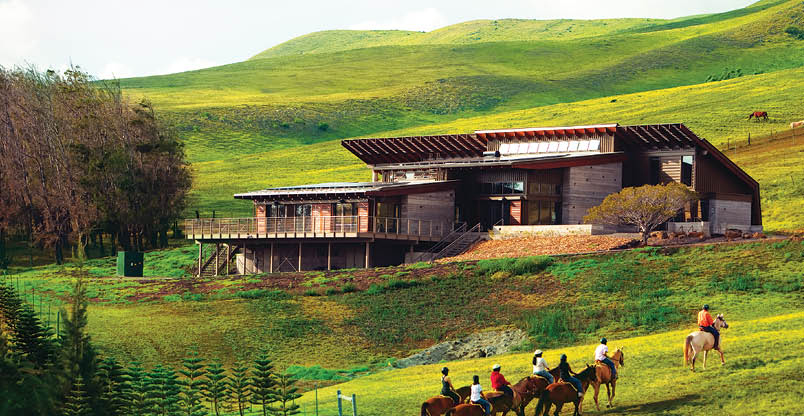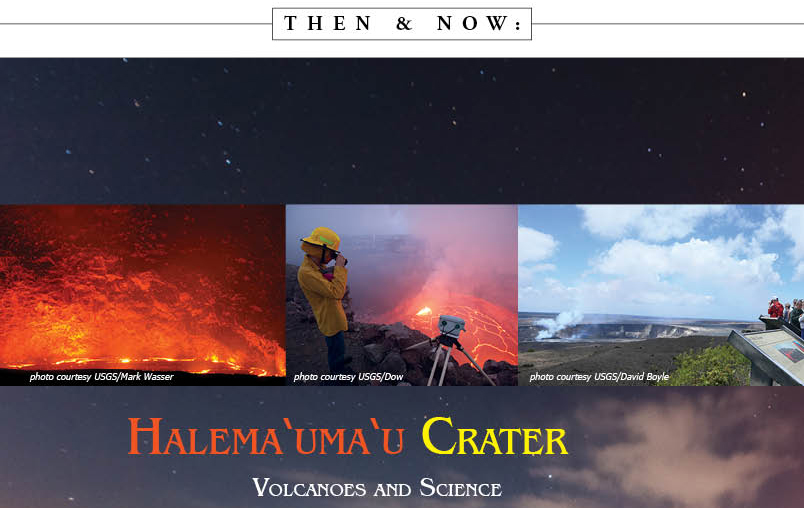
Hawai‘i Preparatory Academy Reduces the Schools Carbon Footprint

By Megan Moseley
The students at Hawai‘i Preparatory Academy (HPA) are pushing the term “going green” to new heights thanks to the construction of the school’s state-of-the-art, one-of-a-kind energy laboratory.
The $3.7 million, 6,100-square-foot facility is truly unique. Replete with wind turbines, an array of photovoltaic panels and a specialized cooling system, this building runs completely on renewable energy and acts as an ongoing, never-ending science project.
Erected on a hillside overlooking the quiet Hawai‘i Island town of Waimea, the HPA energy lab building’s detailed construction makes other science facilities around the nation pale in comparison.
According to Dr. Bill Wiecking, director of HPA’s energy lab and one of the main designers of the facility, there is a purpose for almost every inch of the structure.
The building’s architecture, for example, was intentionally designed to mimic the traditional three-pitch Polynesian roof model. Bill reports that in Polynesian culture, houses were often built facing the equator for better airflow and shade. This model also helps the energy lab’s cooling system work more efficiently.
At nighttime, water goes through the thermal roof panels and is then cooled and stored for use as chilled water for air handling units. Air flows through the building, which is shaped like a wing, up to the peak of the roof, ventilating without noise or power. “It’s like a vacuum,” Bill says of the mechanism.
There is also a certain character within the building, expressed in such features as the ‘ōhi‘a wood column made from salvaged wood, or the building’s outside bench which depicts an outline of the Waimea hills as a reminder of the school’s roots.
The symbolism doesn’t stop there. Throughout the building there are clusters of lava rocks within the concrete walls. According to the school’s website, Vladmir Ossipoff, architect of the HPA chapel, has observed that “the lava rocks in the concrete wall represent our students: they come to us with rough edges.”
Bill also likes to point out the several flat-screen televisions hanging from the middle of the ceiling in the building’s main hall. Desks for the students can be seen surrounding the area, which he compares to a communal fire. He explains that the room is set up in such a way so that it acts as a gathering place for students and teachers, enhancing the likelihood of creative exchanges among them.
Creative exchange is a main focus of HPA and the students and educators who occupy the energy lab. With all the classrooms and public areas being easily accessible from one another, Bill says there is a building-wide fluidity that aids in the free exchange of knowledge.
And the best part—it’s quiet.
“Students like to come in here even when they don’t have class just to do homework or study” he says, noting the lab is more popular than the lunchroom.
The view is worth noting too. The building includes large windows and a front deck that opens to beautiful views of Waimea, Mauna Kea, Mauna Loa, and Hualālai. It is also located away from the other school buildings, giving it a serene and placid feel that would be ideal for any young student trying to study.
The science behind the structure
While there’s plenty to say about the aesthetics of the building, it’s really the science behind it that makes it so special. Indeed, one has the impression that Bill barely scratches the surface during an hour-long tour and interview.
For starters, the creation of the HPA energy lab construction readily satisfied two green building certification standards, those from LEED (Leadership in Energy and Environmental Design) and the Living Building Challenge (LBC).
There are multiple levels of certification for LEED buildings including platinum, gold, silver, or “attempted.” The HPA energy lab received the LEED platinum rating in 2011.
Comparatively, the LBC has even more strict guidelines which must be satisfied to obtain its certification. According to HPA’s website, LBC extends the challenge of LEED to include an assessment of materials sourcing, a one year post-occupancy auditing, and many other criteria.
To receive an LBC certification, the building is judged on seven “petals,” including site, water, energy, health, materials, equity, and beauty. Certification is awarded only if the building meets or exceeds certain criteria for every petal. Remarkably, the HPA energy lab did just that. It is now the third project in the entire world to meet the LBC standard.
According to the LBC website, the building site was intentionally located on the windward side of the school property in order to capitalize on the trade winds that move down the hillside. The site location also provides for optimal solar, thermal and photovoltaic panel performance.
As for the water petal, the building received recognition for a system that treats domestic wastewater and provides for on-site infiltration. The energy lab also has a 10,000-gallon water storage tank, providing potable drinking water.
Perhaps the most interesting aspects of the building are the renewable energy systems. Power for the building is provided by three arrays of photovoltaic panels that provide a total of 26.13 kilowatts of power. The building also has automated louvers that maintain temperature and humidity levels for comfort. In addition, there are more than 400 sensors that measure and control everything from water use to the amount of carbon dioxide in each room.
Bill reports there are multiple benefits to monitoring the amount of CO2 in the building, pointing out that research shows that CO2 levels can affect the way people in small rooms think, focus, and even retain information.
Luckily for the students, they have full control of this information and are able to adjust temperature, humidity, and CO2 levels accordingly to provide a prime-learning environment.
“Imagine if every school could do that,” Bill noted.
Apart from such technological innovations, the materials used for the construction of the building were also distinctive: they were all made from toxic free substances. Even the white boards are made toxic free, a product which according to Bill took some time to create.
Further, all wood in the building is either Forest Stewardship Council (FSC) Certified, or from salvaged sources. Finding some of the materials locally was one of the most challenging aspects of construction. To receive the LBC certification the materials have to be obtained within a certain radius. Also, some materials have to be mass-manufactured and given that the school is located in Hawai‘i, acquiring such materials posed a challenge for the designers. Bill reports the difficulty was nevertheless a blessing in disguise, causing the students and contractors to develop creative solutions.
The final product
The building was completed during a 12-month period with construction finally being finished in January, 2010. It now serves many purposes, for students and faculty alike. Currently, the energy lab allows students to partner with both local and distant scientists and its cutting-edge technology assists with some pretty impressive research projects. These projects include research being conducted at the W.M. Keck Observatory on Mauna Kea, the NOAA Mauna Loa Research lab, and the NASA HISEAS program.
Beyond the features of the building itself, the facility also contains various high-tech tools and equipment that the students can use. The students have access to fabrication equipment, high-tech digital media tools including EEG brain wave headsets, research drones with high-resolution cameras, a 3D printer, DNA cloning tools, and many others. They also have servers that monitor water, light, and energy and many other metrics both in the lab and in other buildings on campus.
According to Bill, HPA students invented their own telemetry, control and monitoring system which accumulates information gathered year after year. Information put into the system helps to enhance the building’s overall functionality by adapting it to weather cycles using student analysis of data.
Ultimately, the energy lab exists to nurture student learning. HPA serves hundreds of students, from all over the world and from on-island. The students use the advanced facility to perform sustainability research that impresses not only their peers and teachers, but the public as well.
Patti Cook of the Waimea Community Association says that she got a chance to hear firsthand from the kids about their experience at the energy lab during a presentation in May.
“The kids were awesome. During the presentation they showed the different kinds of projects they’re working on. The things they are doing are mind boggling” she said. “I think the kind of work they talked about is generally what you would find at a college level.”
She says it’s the building that is giving these students a leg up in education.
“A lot of it is due to that facility. The lab is a smart building which allows them to monitor energy consumption on campus. What it enables the students to do is really amazing.”
According to HPA’s website, the mission of Hawai‘i Preparatory Academy is to provide exceptional learning opportunities in the diverse community while honoring the traditions of Hawai‘i.
Thanks to the creation of this intricate building, HPA is able to do just that, all while reducing the school’s carbon footprint. ❖
Contact Hawai‘i Preparatory Academy: 808.885.7321
Contact the writer


